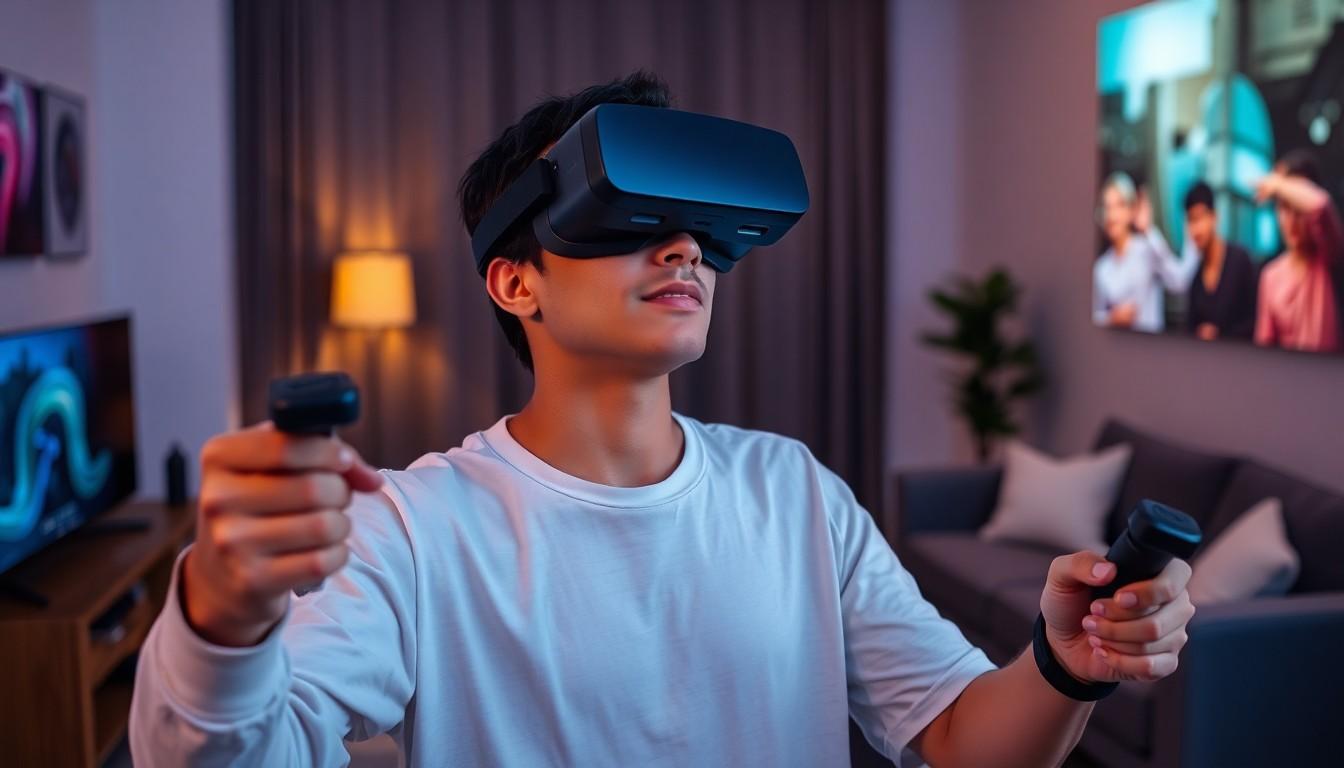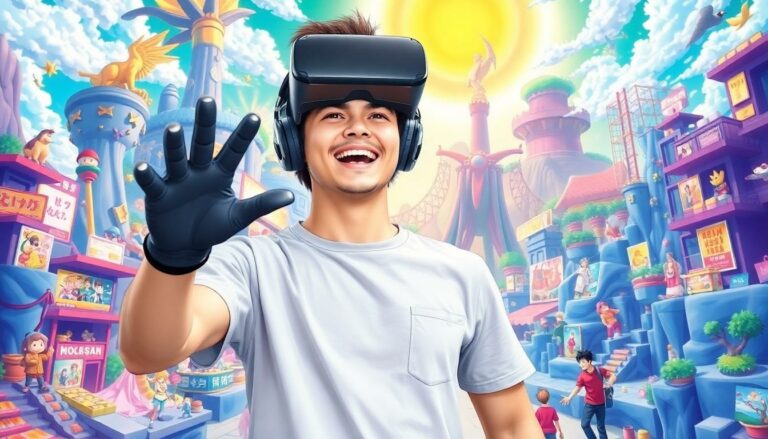Table of Contents
ToggleImagine slipping on a headset and instantly finding yourself on a tropical beach or battling aliens in outer space—all without leaving your living room. Virtual reality solutions have transformed the way people experience the world, making the impossible feel possible. It’s not just for gamers anymore; businesses, educators, and even therapists are tapping into this immersive technology to enhance learning, training, and treatment.
With VR, the future isn’t just coming—it’s here, and it’s pretty spectacular. Whether it’s designing a virtual office or exploring a 3D model of the human body, the applications are endless. So, buckle up as we dive into the fascinating world of virtual reality solutions and discover how they’re reshaping our reality, one pixel at a time. Who knew the future could be this fun?
Overview of Virtual Reality Solutions
Virtual reality (VR) solutions are reshaping various sectors by providing immersive experiences that enhance user engagement. The technology’s versatility spans purposes, such as training simulations, educational tools, and therapeutic interventions.
Definition and Key Concepts
Virtual reality refers to computer-generated environments that simulate physical presence in real or imagined worlds. Key concepts include immersion, which allows users to feel as if they are part of the virtual environment. Interaction enables users to engage with these environments, often through haptic feedback or motion tracking. Experiences in educational settings leverage VR for interactive learning, while businesses use it for training scenarios. This technology promotes a hands-on approach and fosters retention through experiential learning.
Current Market Trends
Market trends show significant growth in the VR sector, with expected revenue to reach $44.7 billion by 2024. Gaming remains a leading application, but sectors like healthcare and education are rapidly expanding their use of VR. Companies are increasingly investing in bespoke VR solutions to meet specific needs, enhancing training and customer engagement. The incorporation of augmented reality (AR) into VR experiences is gaining popularity, further blurring the lines between virtual environments and reality. Innovations in hardware, such as lighter headsets and improved graphics, continue to drive user adoption and satisfaction.
Types of Virtual Reality Solutions

Virtual reality solutions encompass various technologies that create immersive experiences. These solutions include hardware components and software applications that work together to transport users into virtual worlds.
Hardware Components
Hardware components play a crucial role in delivering virtual reality experiences. Headsets provide visual immersion, while advanced sensors track user movements. Controllers enhance interaction, enabling users to engage with the virtual environment. Additionally, audio systems improve immersion with spatial sound. High-performance computers or gaming consoles power these devices, offering robust processing capabilities. Together, these hardware elements create engaging and realistic environments.
Software Applications
Software applications drive the functionality of virtual reality solutions. Development platforms provide tools for creating VR content, allowing designers to build interactive experiences. Training modules utilize VR for effective skill development in fields like healthcare and aviation. Educational simulations enhance classroom learning, offering immersive lessons that captivate students. Therapeutic programs leverage VR for exposure therapy and stress relief. Each application harnesses VR’s potential, advancing its use across various sectors.
Benefits of Virtual Reality Solutions
Virtual reality solutions offer a range of advantages across multiple sectors. Immersive technology transforms user engagement and effectiveness in various applications.
Enhanced User Experience
Enhanced user experience stands as a primary benefit of virtual reality. Users immerse themselves in lifelike simulations that captivate attention. Interaction becomes more intuitive, as individuals can manipulate virtual objects seamlessly. The inclusion of haptic feedback elevates this enjoyment, allowing users to sense touch in a virtual context. Realistic environments help participants understand complex concepts or scenarios effectively. VR fosters deeper emotional connections, which can profoundly impact memory retention and understanding.
Improved Training and Education
Improved training and education result from the integration of virtual reality solutions. Organizations leverage VR to create realistic simulations that mirror real-world challenges. Trainees engage with environments that develop skills required for their professions. Educational institutions utilize VR to provide students with hands-on experiences, enhancing learning beyond traditional methods. The technology accommodates various learning styles, allowing visual and kinesthetic learners to thrive. Studies indicate that VR increases knowledge retention by up to 75 percent compared to conventional training methods.
Challenges in Implementing Virtual Reality Solutions
Virtual reality solutions face multiple challenges during implementation. Understanding these obstacles aids businesses, educators, and healthcare providers in adopting this technology efficiently.
Technical Limitations
Technical limitations hinder the effectiveness of virtual reality solutions. High-performance computers or gaming consoles often require significant processing power for smooth and immersive experiences. Display quality varies across devices, affecting users’ immersion. Latency issues can disrupt the experience, causing motion sickness in some users. Tracking technology must function accurately to prevent disorientation during interaction. Compatibility between various hardware and software components remains crucial for seamless operation.
Cost Considerations
Cost considerations also play a critical role in adopting virtual reality solutions. Initial investment for advanced hardware and software can be substantial, which may deter organizations from pursuing this technology. Ongoing maintenance and technical support add to the financial burden. Training employees to use VR tools effectively incurs additional expenses. Despite the potential for improved outcomes, many organizations must carefully weigh these costs against anticipated benefits. As the market evolves, prices may decrease, promoting greater accessibility and adoption in the future.
Future of Virtual Reality Solutions
Virtual reality solutions are evolving rapidly, driven by advancements in technology and increasing adoption across industries. Emerging trends shape the direction of VR’s future, enhancing its impact and potential.
Emerging Technologies
Innovations like artificial intelligence significantly enhance virtual reality solutions. AI optimizes user experiences by personalizing content and improving interaction. Integration with 5G technology enhances connectivity, reducing latency and allowing for seamless experiences. Moreover, advancements in computer vision improve tracking accuracy, making interactions more intuitive. Other technologies, such as eye tracking, gain prominence, enabling users to interact naturally with virtual environments. Augmented reality applications extend further, allowing hybrid experiences where digital elements blend with the real world. These technologies combine to create richer, more engaging experiences.
Predictions for Industry Growth
Predictions indicate the virtual reality market will surpass $44.7 billion by 2024. Various industries, including healthcare and education, increasingly adopt VR solutions, driving growth. As organizations recognize VR’s potential, investments in customized applications rise. Market analysts anticipate significant advancements in hardware, with lighter headsets and enhanced graphics improving user satisfaction. Educational institutions are likely to incorporate VR more often, leading to better learning outcomes. Enhanced training programs leverage realistic simulations, addressing specific needs across different sectors. Overall, growing interest in VR solutions suggests a promising trajectory, fostering immersive experiences that resonate with users.
Virtual reality solutions are reshaping how individuals and organizations engage with technology. With their ability to create immersive experiences across various sectors, VR is proving to be a game-changer in training, education, and therapy. As advancements in hardware and software continue to emerge, the potential for VR applications will only expand.
The growing investment in tailored solutions indicates a strong belief in VR’s capabilities to enhance learning and emotional connections. While challenges remain, the trajectory of virtual reality points toward increased accessibility and integration into everyday life. As industries embrace this innovative technology, the future looks bright for virtual reality solutions, promising richer experiences and improved outcomes for users everywhere.




